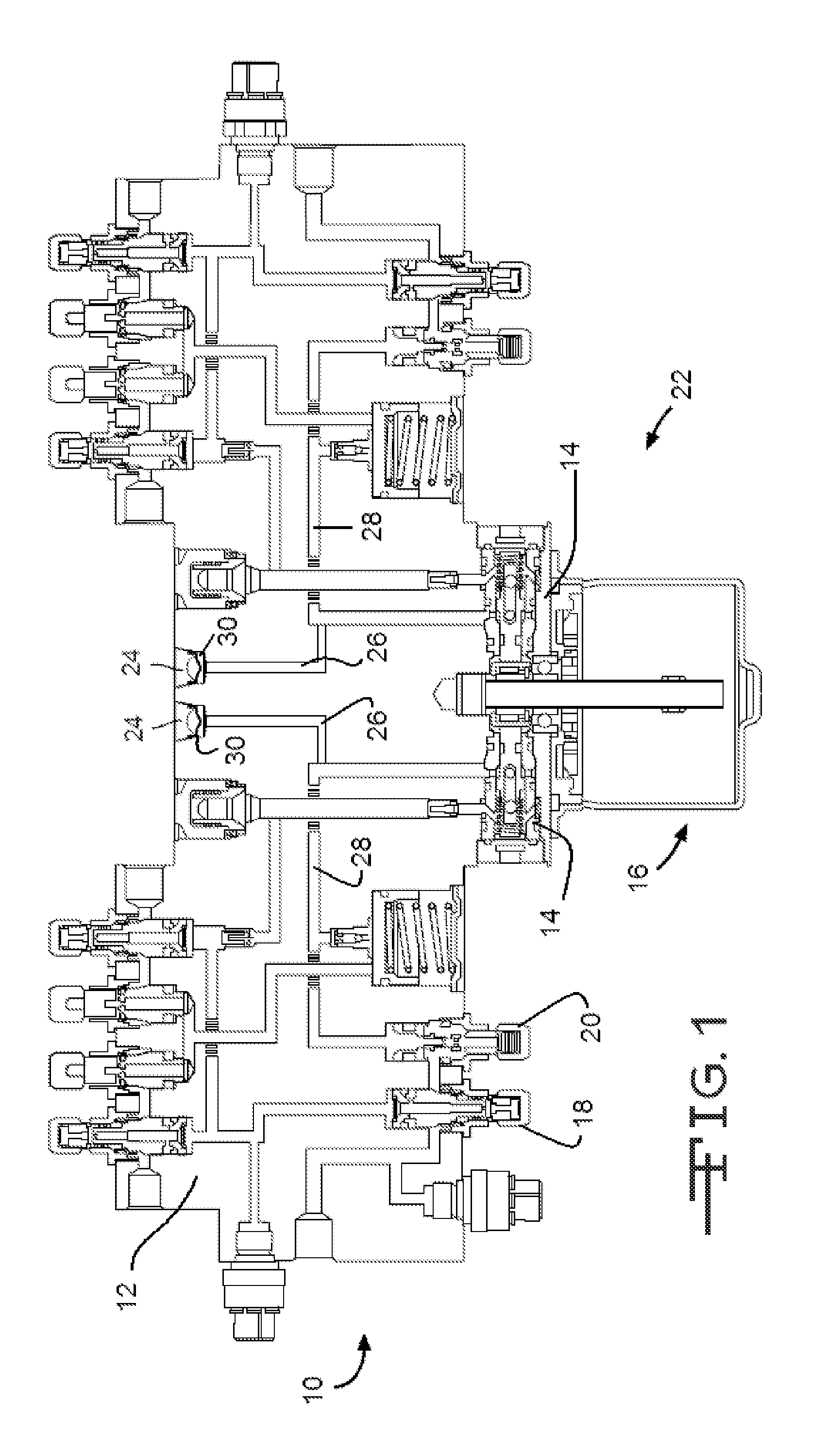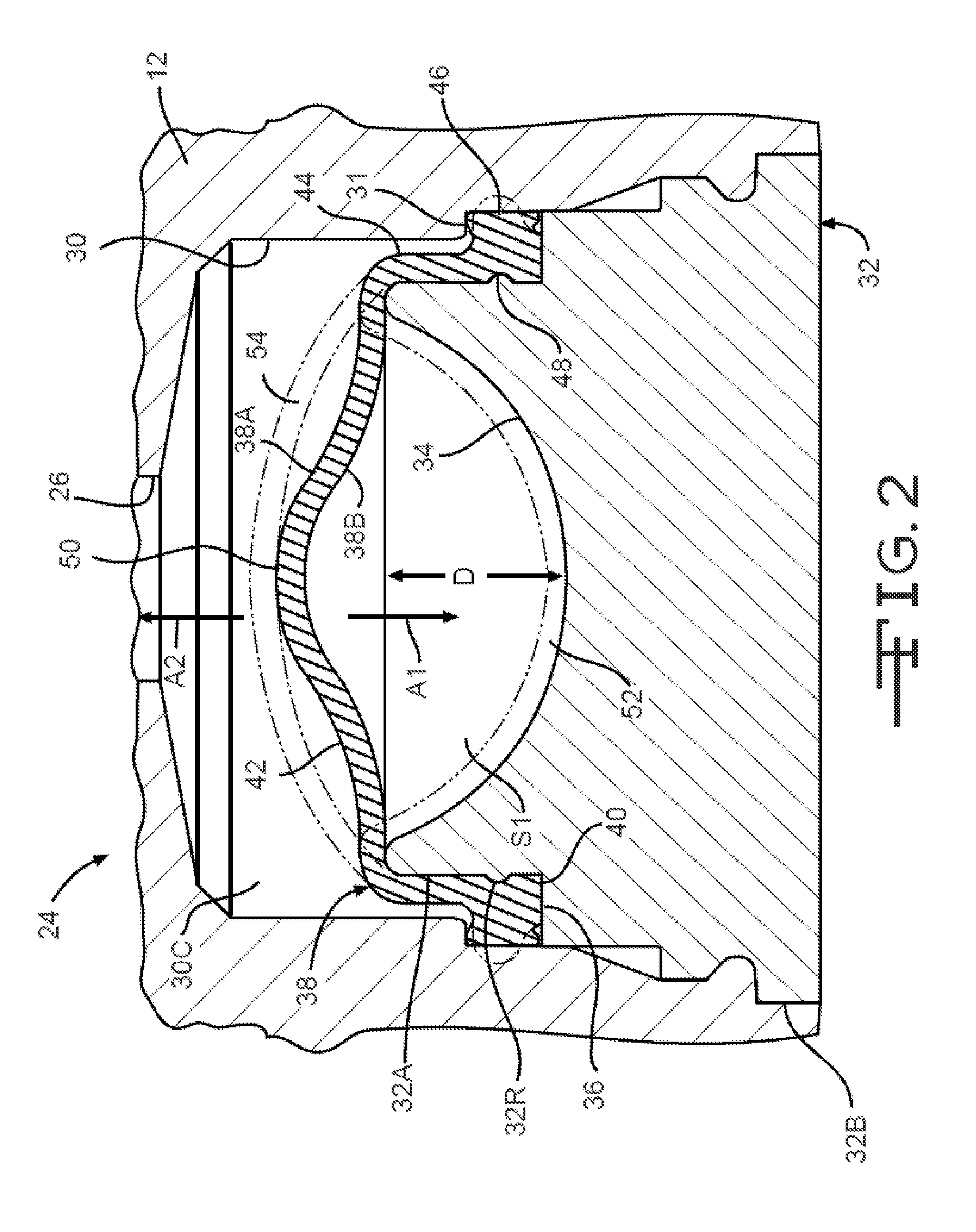Damping Element for a Motor Vehicle Hydraulic System
a technology for hydraulic systems and motor vehicles, applied in mechanical equipment, braking systems, transportation and packaging, etc., can solve problems such as hydraulic fluid pulsation, rapid brake pressure build-up rates, and hydraulic pump operating capacity reduction
- Summary
- Abstract
- Description
- Claims
- Application Information
AI Technical Summary
Benefits of technology
Problems solved by technology
Method used
Image
Examples
first embodiment
[0032]the attenuator 24 is illustrated in FIG. 2. In the illustrated embodiment, the attenuator 24 is disposed in the attenuator bore 30 of the valve housing 12. In the illustrated embodiment, the valve housing 12 is a hydraulic control unit (HCU). The bore 30 includes a stepped portion 31 which defines a seat for a sealing portion of a membrane 38, described below.
[0033]The fluid conduit 26 is formed in the HCU 12 and allows pressurized fluid flow between the pump 20 and the bore 30 via a pump fluid inlet conduit 28, shown in FIG. 1.
[0034]The attenuator 24 includes a support body, also known as an end cap 32, that is mounted in the bore 30 in a fluid-tight manner, such as by caulking, clinching, staking, press fitting, bonding, welding, or any other suitable method or combination of methods. The attenuator 24 may be permanently or removably mounted in the bore 30. The end cap 32 includes a first end 32A which faces the fluid conduit 26. A cavity 34, having a concave profile, is for...
second embodiment
[0038]Referring now to FIG. 3, a portion of the attenuator is shown at 124. The attenuator 124 is similar to the attenuator 24 and includes the end cap 32 and a membrane 138. The membrane 138 is similar to the membrane 38, is generally cup-shaped, and includes an open end 140, a closed end 142, and a substantially cylindrical side wall 144. A circumferentially outwardly extending sealing flange 146 is formed at the open end 140. A circumferentially outwardly extending groove 148 is formed on the inner surface of the side wall 144 opposite the flange 146. The closed end 142 has a substantially domed shape extending across the first end 32A of the end cap 32 and extending toward the conduit 26. As shown, the closed end 142 has a generally arcuate cross-sectional shape.
third embodiment
[0039]Referring now to FIG. 4, a portion of an attenuator is shown at 224. The attenuator 224 is similar to the attenuator 24 and includes an end cap 232 and a membrane 238. The end cap 232 includes a first end 232A which faces the fluid conduit 26. A concave cavity 234 is formed in the first end 32A of the end cap 232. The concave cavity 234 is configured as having a shallower depth than the depth D of the concave cavity 34, though such is not required. In the illustrated embodiment, the first end 232A of the end cap 232 has a diameter smaller than a diameter of a second end 232B of the end cap 232. A stepped portion 236 is formed between the first end 232A and the second end 232B of the end cap 232 and defines a seat for a sealing portion of the membrane 238. A circumferentially inwardly extending groove 232G is formed on the outer surface of the first end 232A of the end cap 232.
[0040]The membrane 238 is similar to the membrane 38, is substantially cup-shaped and includes an open...
PUM
 Login to View More
Login to View More Abstract
Description
Claims
Application Information
 Login to View More
Login to View More - R&D
- Intellectual Property
- Life Sciences
- Materials
- Tech Scout
- Unparalleled Data Quality
- Higher Quality Content
- 60% Fewer Hallucinations
Browse by: Latest US Patents, China's latest patents, Technical Efficacy Thesaurus, Application Domain, Technology Topic, Popular Technical Reports.
© 2025 PatSnap. All rights reserved.Legal|Privacy policy|Modern Slavery Act Transparency Statement|Sitemap|About US| Contact US: help@patsnap.com



